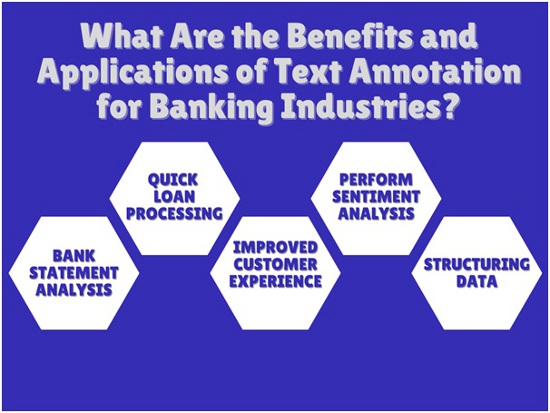The banking industry is constantly under pressure to implement new technologies to stay competitive and highly responsive in terms of customer service. Banks can do this by using artificial intelligence (AI) and machine learning (ML) models. However, AI/ML models require appropriately labeled datasets to perform as per requirement. Herein, text annotation, an important aspect of data annotation, comes in.
Text annotation is the process of giving a digital file or document’s content labels. Depending on the scope of a project, it could include emphasizing grammar, syntax, keywords, phrases, emotions, sarcasm, feelings, and more. Once data is labeled, the training datasets are fed to the computer vision models, allowing them to learn various parts of language and sentence construction and better interpret human interactions. Banks widely use machine learning models to improve work efficiency.
Read on to learn how text annotation helps to train AI/ML models used in the banking sector.
How Does Text Annotation Help in Training AI/ML Models for Banks?
It’s too complicated for machines to understand human languages, especially the emotion behind them. Hence, we use text annotation to train these machines. The primary task of text annotation is to label the words, sentences, and phrases in textual content so that it gets easy for AI/ML models to understand the meaning and emotions of the text.
These training datasets are fed to ML models to understand the text easily. The most well-known application of this is chatbots. Banks use chatbots to answer the doubts of their customers. However, chatbots can have drawbacks and might fail if deployed incorrectly. People have different speech patterns, and occasionally, text chatbots cannot comprehend what is being said. This can result in them responding in an irrelevant, nonsensical, or deceptive way.
To avoid such issues, chatbots are used and trained using various techniques of text annotation. Text annotation can help the chatbot understand the message’s meaning, intent, and sentiment. This helps banks improve their bot performance, indirectly leading to customer satisfaction.
Most banking and financial industries opt for text annotation (either by hiring an in-house team or outsourcing text annotation services) to train computer vision models according to their needs.
What Are the Benefits and Applications of Text Annotation for Banking Industries?


Here are some benefits of text annotation, explained through use cases, for banking industries.
➔ Bank Statement Analysis
Banks have moved toward digitalization with the use of optical character recognition (OCR). OCR helps to transform an image of text into a machine-readable text format. Now, banks don’t have to go through hundreds of files to perform analysis. They can automatically analyze bank statements by extracting the account owner’s name, address, and issuance date to confirm their address using bank statement OCR. This OCR is taught through named entity annotation to identify the holder’s name, address, and other details.
➔ Quick Loan Processing
Financial organizations typically require income documentation of potential clients in order to sanction a loan request. They take at least 10 days to communicate with respective banks to complete this process before contacting borrowers to confirm their income. However, organizations may quickly and easily examine creditworthiness with just one click with the use of machine learning models. With text classification, the AI models are trained to understand the applicant’s credit scores. For instance, if the credit score is above a certain value, only then would the applicant be considered eligible for the loan. Based on this, banks quickly decide whether or not a client would fail on the repayment of their loans. Accordingly, they process the loan. The entire procedure takes less time and saves a lot of effort.
➔ Improved Customer Experience
It is essential that chatbots understand the customer’s intent behind a text. Text annotation is used to train AI/ML models to understand the customer’s intent, such as a request, command, affirmation, and disappointment. This enables the chatbots to recognize the user’s intent and answer appropriately. For instance, when a customer texts, “The expected service is delayed,” through text annotation training, the chatbot recognizes the text’s intent (in this case, disappointment), analyzes the message, and responds. Text annotation protects banks from annoying their customers with irrelevant chatbot replies. This helps the bank to improve customer satisfaction.
➔ Perform Sentiment Analysis
It is far more challenging for a machine to detect hidden meaning in texts that include humor, sarcasm, or other informal communication styles. Using sentiment annotation, a subcategory of text annotation, AI/ML models are trained to classify the text or sentence according to its emotions. For instance, ‘I am happy with the service.’ This can be marked as a ‘happy’ or ‘satisfied customer’ using text annotation. After training, the machine can easily understand the emotion behind the text. Banks can use trained models to perform sentiment analysis. They can evaluate the feedback forms, social media comments, and posts to understand how the public perceives the bank’s service and which platforms tend to have a more positive or negative sentiment. Eventually, this can help banks in changing their communication strategies.
➔ Structuring Data
Banks collect ample data daily. These data include bank account details, feedback forms, insurance claims, and many more. If the data are not classified under their respective category, it can create confusion. By performing text annotation, banks can label their data and keep them in a structured form. Text annotation helps to label named entities in the database. For example, the name of the account holder, their address, the organization they work in, and the region from which they belong. This makes the data more structured. Additionally, it becomes easy for the bank to retrieve specific information from the database.
Conclusion
The banking sector is quite large and witnesses hundreds of consumers every day. Hence, excellent customer service is a huge pressure point for them. Well-trained AI-enabled technology helps them to deal with daily challenges with respect to the generation of bank statements, processing loan documents, improving customer experience, and many more. However, for the smooth functioning of computer vision models, text annotation needs to be deployed with accuracy in the banking sector.









